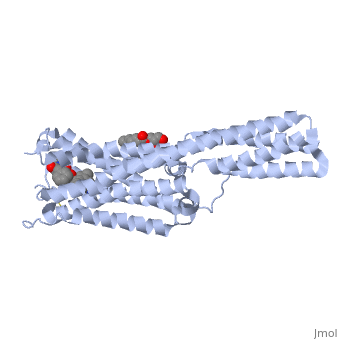5-hydroxytryptamine receptor
From Proteopedia
(Difference between revisions)
| Line 24: | Line 24: | ||
5-HT3 antagonists have been predominantly used as an antiemetic drug in relieving treating symptoms such as nausea and vomiting for a cancer patient receiving chemotherapy. Three high affinity antagonist often used are granisetron, tropisteron and ondansetron. The common structure shared among 5-HT3 antagonists contains an amine with an aromatic ring system and a carbonyl group. <ref name = "two" /> Experimental homology modeling suggests that 5-HT3 antagonists have aromatic rings that form π-π interactions with the tyrosine, Y143 and tryptophan, W183, side chains of the 5-HT3 receptor. It is also theorized that the antagonist contain carbonyl groups which accept hydrogen bonds from serine, S227, side chain of the 5-HT3 receptor.<ref>Maksay G, Zsolt B, Miklós S. ''Binding Interactions of Antagonists with 5‐Hydroxytryptamine 3A Receptor Models.'' Journal of Receptors and Signal Transduction 23.2-3 (2003): 255-70. [http://www.tandfonline.com/doi/full/10.1081/RRS-120025568 DOI:10.1081/RRS-120025568]</ref> During the binding of granisteron to the 5-HT3 receptor, the aromatic rings sit within W183 and Y234 and an azabicyclic ring within W90 and F226 of the binding pocket.<ref name = "two" /> Once a 5-HT3 antagonist has bound to a 5-HT3 receptor, serotonin binding is inhibited.<ref>Brunton LL, Lazo JS, Parker KL. (2006). Goddman & Gilman's The Pharmacological Basis of Therapeutics. New York: McGraw-Hill. pp. 1000–3. ISBN 978-0-07-142280-2.</ref><br /> | 5-HT3 antagonists have been predominantly used as an antiemetic drug in relieving treating symptoms such as nausea and vomiting for a cancer patient receiving chemotherapy. Three high affinity antagonist often used are granisetron, tropisteron and ondansetron. The common structure shared among 5-HT3 antagonists contains an amine with an aromatic ring system and a carbonyl group. <ref name = "two" /> Experimental homology modeling suggests that 5-HT3 antagonists have aromatic rings that form π-π interactions with the tyrosine, Y143 and tryptophan, W183, side chains of the 5-HT3 receptor. It is also theorized that the antagonist contain carbonyl groups which accept hydrogen bonds from serine, S227, side chain of the 5-HT3 receptor.<ref>Maksay G, Zsolt B, Miklós S. ''Binding Interactions of Antagonists with 5‐Hydroxytryptamine 3A Receptor Models.'' Journal of Receptors and Signal Transduction 23.2-3 (2003): 255-70. [http://www.tandfonline.com/doi/full/10.1081/RRS-120025568 DOI:10.1081/RRS-120025568]</ref> During the binding of granisteron to the 5-HT3 receptor, the aromatic rings sit within W183 and Y234 and an azabicyclic ring within W90 and F226 of the binding pocket.<ref name = "two" /> Once a 5-HT3 antagonist has bound to a 5-HT3 receptor, serotonin binding is inhibited.<ref>Brunton LL, Lazo JS, Parker KL. (2006). Goddman & Gilman's The Pharmacological Basis of Therapeutics. New York: McGraw-Hill. pp. 1000–3. ISBN 978-0-07-142280-2.</ref><br /> | ||
For more details see [[5-ht3a receptor]]. | For more details see [[5-ht3a receptor]]. | ||
| + | |||
| + | ==3D structures of 5-hydroxytryptamine receptor== | ||
| + | [[5-hydroxytryptamine receptor 3D structures]] | ||
| + | |||
</StructureSection> | </StructureSection> | ||
==3D structures of 5-hydroxytryptamine receptor== | ==3D structures of 5-hydroxytryptamine receptor== | ||
Revision as of 09:48, 20 February 2019
| |||||||||||
3D structures of 5-hydroxytryptamine receptor
Updated on 20-February-2019
References
- ↑ Goodsell D. Serotonin Receptor. RCSB PDB-101 (2013) DOI: 10.2210/rcsb_pdb/mom_2013_8
- ↑ 2.0 2.1 2.2 2.3 Wang C, Jiang Y, Ma J, Wu H, Wacker D, Katritch V, Han GW, Liu W, Huang XP, Vardy E, McCorvy JD, Gao X, Zhou EZ, Melcher K, Zhang C, Bai F, Yang H, Yang L, Jiang H, Roth BL, Cherezov V, Stevens RC, Xu HE. Structural Basis for Molecular Recognition at Serotonin Receptors. Science. 2013 May 3; 340(6132): 610–614. PMID:3644373 [1]
- ↑ Wiebke J, Schymura Y, Novoyatleva T, Kojonazarov B, Boehm M, Wietelmann A, Luitel H, Murmann K, Krompiec DR, Tretyn A, Pullamsetti SS, Weissmann N, Seeger W, Ghofrani HA, Schermuly RT. 5-HT2B Receptor Antagonists Inhibit Fibrosis and Protect from RV Heart Failure. Biomed Res Int. 2015; 2015: 438403. PMID:4312574 [2]
- ↑ Nebigil, Etienne, Schaerlinger, Hickel, Launay, Maroteaux. Developmentally Regulated Serotonin 5-HT2B Receptors. DOI: 10.1016/S0736-5748(01)00022-3
- ↑ Berumen LC, Rodriguez A, Miledi R, Gracia-Alcocer G. Serotonin Receptors in Hippocampus. ScientificWorldJournal. 2012;2012:823493. Epub 2012 May 2. PMID:3353568 [3]
- ↑ Millan MJ. Serotonin 5-HT2C receptors as a target for the treatment of depressive and anxious states: focus on novel therapeutic strategies. Therapie. 2005 Sep-Oct;60(5):441-60. PMID:16433010
- ↑ Ge T, Zhang Z, Lv J, Song Y, Fan J, Liu W, Wang X, Hall FS, Li B, Cui R. The role of 5-HT2c receptor on corticosterone-mediated food intake. J Biochem Mol Toxicol. 2017 Jun;31(6). doi: 10.1002/jbt.21890. Epub 2017 Feb 10. PMID:28186389 doi:http://dx.doi.org/10.1002/jbt.21890
- ↑ Hassaine G,Cedric D, Luigino G, Romain W, Menno BT, Ruud H, Alexandra G, Henning S, Takashi T, Aline D, Christophe M, Xiao-Dan L, Frederic P, Horst V, Hugues N. X-ray Structure of the Mouse Serotonin 5-HT3 Receptor. Nature 512.7514 (2014): 276-81.DOI:10.1038/nature13552
- ↑ 9.0 9.1 9.2 Thompson AJ, Lummis SCR. 5-HT3 Receptors. Curr Pharm Des. 2006; 12(28): 3615–3630. PMID:2664614 [4]
- ↑ Maksay G, Zsolt B, Miklós S. Binding Interactions of Antagonists with 5‐Hydroxytryptamine 3A Receptor Models. Journal of Receptors and Signal Transduction 23.2-3 (2003): 255-70. DOI:10.1081/RRS-120025568
- ↑ Brunton LL, Lazo JS, Parker KL. (2006). Goddman & Gilman's The Pharmacological Basis of Therapeutics. New York: McGraw-Hill. pp. 1000–3. ISBN 978-0-07-142280-2.
Proteopedia Page Contributors and Editors (what is this?)
Michal Harel, Alexander Berchansky, Joel L. Sussman, Zachary Falk, Brittany Spence, Matthew P Cabrera, Jaime Prilusky

